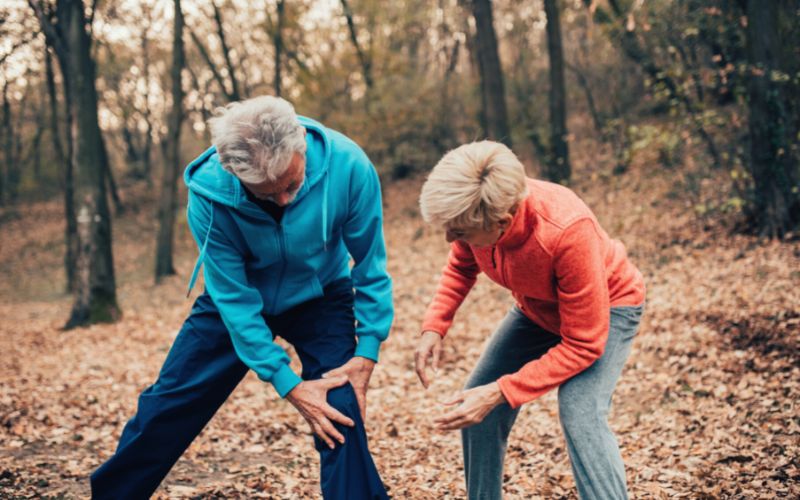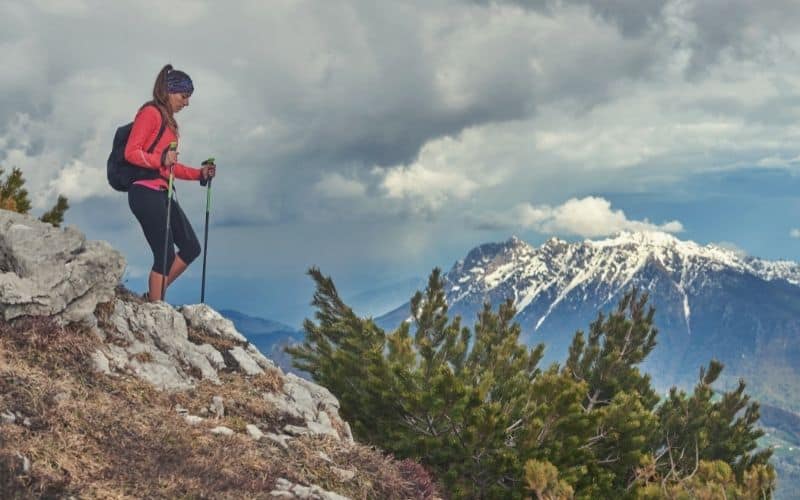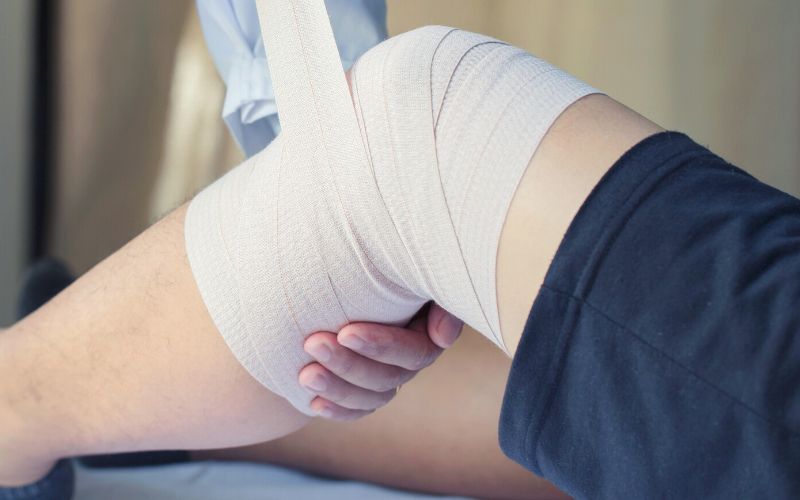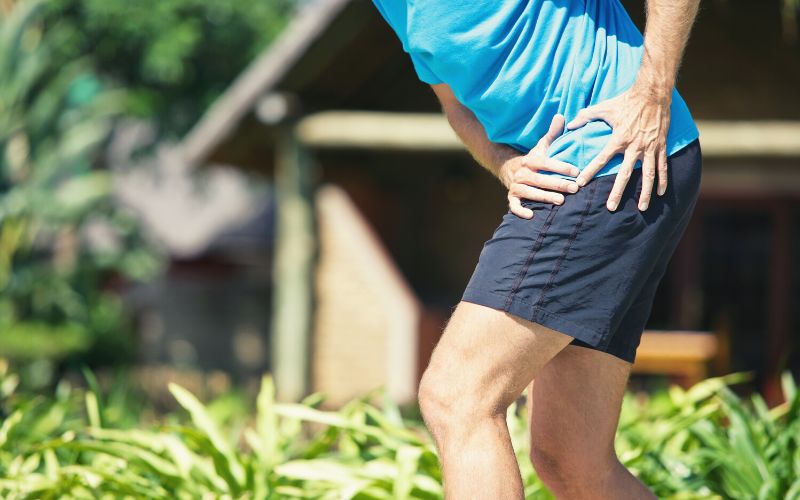Going on a hike is the perfect way to unwind and enjoy the great outdoors! But what happens when the very act of hiking itself is inducing pain in your knees?
Whether it’s a sharp, shooting pain on the outer knee or a burning sensation with redness and swelling, knee pain can be a serious issue that you can’t ignore.
In this guide to the top 9 causes, we’ll review the most common conditions, their signs and symptoms, treatment options, and tips on preventing them.
Table of Contents
9 Causes of Knee Pain and How to Treat It
Here are the most common types of knee pain caused by hiking, the symptoms, and how to treat knee pain. Remember, it’s important to take a break from hiking and seek medical care if you think you may have any of these injuries.

1. Bursitis
A painful and swollen knee that hurts to the touch may indicate knee bursitis pain. This type of pain results from an inflamed bursa sac and is usually felt below the joint on the inner side of the knee.
These fluid-filled sacs provide padding and protection between your knee tendons, muscles, joints, and bones. Frequent kneeling, overuse, falling and hitting the knee, or intense activity can cause inflammation and pain.
There are a few steps you can take to treat an inflamed bursa. You should stop exercising for a few days and rest your knee.
Try to ice your knee for about 20 minutes 3 to 4 times daily. If you don’t have an ice pack, use a bag of frozen veggies instead and elevate your injured knee to help reduce the swelling. If it still hurts, take an anti-inflammatory medication like ibuprofen.

2. Anterior Cruciate Ligament Damage
Damage to the anterior cruciate ligament (ACL) is one of the most common and potentially severe knee injuries. This ligament is a sturdy tissue connecting the thigh bone to the shinbone.
An ACL injury tear or sprain can happen during a sudden change or stop in direction or by flexing the ankle too much while hiking. Instant swelling, severe pain, restricted motion, a popping sensation or sound, and the inability to put weight on your knee are some of the symptoms of ACL damage.
Treatments for ACL injuries vary depending on the severity of the damage. For some, resting and rehabilitating the knee could do the trick, while others may need ligament replacement surgery and physical therapy.

3. Meniscus Tear
A tear to the meniscus is another common cause of knee damage while hiking. The meniscus is a part of the cartilage in the knee that pads and stabilizes the joint and protects the bone from wearing down.
Twisting the knee just slightly the wrong way can cause a debilitating and painful meniscus tear. Sometimes, the torn cartilage gets caught in the knee joint and causes it to lock up.
Some symptoms of a meniscus tear include pain, swelling, a popping sensation, trouble bending and extending your leg, and a knee that gets stuck.
Meniscus tear treatments depend on the size and location of the injury, age, and activity level. For small tears, resting and icing your knee, using a compress to control the swelling, anti-inflammatory medications for pain relief, and elevating the knee may suffice. But if the knee is locked in place, you may require surgery.

4. Tendinitis
Tendinitis, also known as patellar tendinitis, is an inflammation or irritation of the tendon connecting the knee cap to the shinbone.
Tendinitis commonly happens due to over-exercising, especially things like repetitive jumping. This type of pain usually happens after continued stress on the knee.
Increasing pain and tenderness around your kneecap may be a sign of tendinitis. Swelling and a burning sensation can occur in the knee.
Treating tendinitis typically involves the usual knee pain remedies like resting, icing, elevating, and taking anti-inflammatory drugs.

5. Tendinosis
Not to be confused with tendinitis, tendinosis is a chronic condition that is not caused by inflammation. It occurs when a tendon is damaged repeatedly and doesn’t recover properly, leading to scarring and thickening.
With tendinosis, there is no visual symptom, but it is still painful and you may suffer from stiffness or limited mobility. This condition is more common in older people and those that do repetitive motions.
The typical tendinosis treatment is rest and over-the-counter anti-inflammatory medication.
6. Osteoarthritis
Osteoarthritis (OA), also called “wear-and-tear arthritis”, is the most common type of arthritis. It occurs most in weight-bearing joints like the knees in people over the age of 50.
The condition causes the knee joint’s cartilage to become rigid, inflexible, and prone to damage. Osteoarthritis can lead to degeneration or complete loss of the cartilage over time. This typically causes stiffness upon waking and aching or swelling during hiking.
Treatments for Osteoarthritis vary, but some of them are exercise, weight loss, muscle stretching exercises, compresses, and medications.

7. Synovial Plica Syndrome
There is a fold in the tissue encompassing the joint in the knee known as the plica. A liquid-filled synovial membrane envelops the fold.
Synovial plica syndrome occurs when there’s an inflamed plica due to overusing it or too much stress on it. The signs of this type of injury are an achy pain located in the center of the kneecap, along with swelling and tenderness.
Luckily, plica problems usually improve without the need for surgery. Home remedies include resting and icing the knee, stretching, and anti-inflammatory medicine.

8. Patellofemoral Pain Syndrome
Patellofemoral pain syndrome is commonly known as runner’s knee. It causes pain in the kneecap or front of the knee and buckling of the knee. It’s typically a dull, achy pain that gets worse when climbing stairs, kneeling, or sitting for a long time.
This syndrome occurs due to an imbalance of the muscles, tightness, or problems with alignment.
Patellofemoral pain syndrome is more common in women than in men and in people that do exercises involving lots of running and jumping.
Most hikers with this condition will get better on their own with the right treatments and enough time to heal. Some of the treatments for runner’s knee are resting and icing the knee, wearing a bandage, elevating the leg, taking NSAIDs for pain relief, doing strengthening exercises, and using arch support for your shoes.

9. Iliotibial Band Syndrome
There’s a thick piece of tissue that stretches from your outer knee to your hip called the iliotibial (IT) band. This band can become inflamed, tight, or swollen, if overused during strenuous activities, leading to iliotibial band syndrome.
Iliotibial band syndrome causes pain on the outer side of the knee that can run up the thigh to the hip, warmth, redness, and burning. This is a common injury when hiking downhill.
Recovery from IT syndrome involves resting for about 6 weeks, avoiding activities that trigger the pain, taking over-the-counter pain relievers, and icing the knee.

How to Prevent Knee Pain and Injuries While Hiking
As is the case with most injuries, prevention is the best way to avoid pain in your knees post-hike. You’ve already taken the time to learn about the potential causes of knee pain, now let’s go over some simple steps you can take to prevent any pain from occurring in the first place.
Use the Right Shoes
Whether it’s hiking boots or hiking shoes, choose comfortable shoes that fit properly, protect your feet, and support your ankles and knees. Make sure to lace up well!
Wear a Knee Brace
If you already have a knee injury, it’s best to get a knee brace made specifically for hiking to protect your knee from further damage.

Reduce Your Pack Weight
More weight on top of your body weight means more stress on your knee joints and a higher risk of injury. Lighten your load by only carrying essentials or by replacing heavy items with lighter versions.
Stretch Before and After Hiking
Start each hike with a good stretch to warm up and loosen your muscles. End your hike with another stretch to cool down.

Use Hiking Poles
Research suggests that hiking poles help redistribute the pressure put on your knees during downhill hiking, plus they help prevent falls.
Even if you don’t use them the entire hike, keep trekking poles handy for downhill hikes, or walk in a zig-zag pattern to reduce the stress on your knees.

Take it Slow and Steady
Slow down and step lightly when hiking. Pay attention to the trail’s incline and be intentional with your steps. Going too quickly puts additional strain on your knees and increases the risk of slips and injuries.
Knee Pain After Hiking…
Don’t get bummed out by knee pain after hiking! Now you know how to treat the most common types of pain and what steps you can take to prevent it from happening in the first place.
To treat most knee pain, start by resting and icing the knee, elevating the leg, taking an anti-inflammatory, and then contacting your doctor for further advice.
Some of the best ways to avoid hiker’s knees are to take preventative steps like wearing the proper shoes, warming up, and using trekking poles when hiking downhill.
Do you have any other tips for avoiding knee pain? Let us know in the comments below. If you like this post, share it with your family and friends.


Pain in outside of knee making bending and weight bearing painful and tough to get off mountain. What is it?